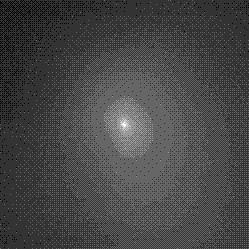Comet optical point signal simulation method for deep space exploration
An optical signal and simulation method technology, applied in the field of aerospace navigation, can solve problems such as comet simulation, and achieve the effect of good effect, simple and intuitive drawing, and reliable dynamic optical signal.
- Summary
- Abstract
- Description
- Claims
- Application Information
AI Technical Summary
Problems solved by technology
Method used
Image
Examples
Embodiment Construction
[0032] The present invention will be further introduced below in conjunction with specific embodiments:
[0033] 1. Comet optical signal model
[0034] Such as figure 1 Shown is a schematic diagram of comet morphology. A typical comet morphology includes four parts: nucleus, coma, tail and cloud. The nucleus and the coma are collectively called the head, but only for most comets. Some comets do not necessarily have all four parts, and some do not have a tail or even a coma. It is the same comet whose shape is constantly changing during its orbiting the sun. As it approaches the sun, coma and tail gradually appear; while away from the sun, the coma and tail gradually disappear.
[0035] When the comet is far away from the detector, the detector (with a navigation camera on the detector) observes a point signal that is combined by the comet nucleus, coma, and background brightness. Since the point signal is not just a simple point, it There is also a halo formed by the coma, so it ca...
PUM
 Login to View More
Login to View More Abstract
Description
Claims
Application Information
 Login to View More
Login to View More - R&D
- Intellectual Property
- Life Sciences
- Materials
- Tech Scout
- Unparalleled Data Quality
- Higher Quality Content
- 60% Fewer Hallucinations
Browse by: Latest US Patents, China's latest patents, Technical Efficacy Thesaurus, Application Domain, Technology Topic, Popular Technical Reports.
© 2025 PatSnap. All rights reserved.Legal|Privacy policy|Modern Slavery Act Transparency Statement|Sitemap|About US| Contact US: help@patsnap.com



